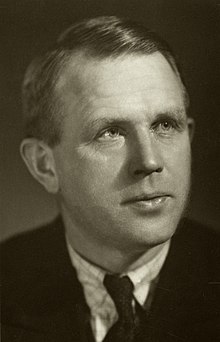Artturi Ilmari Virtanen
Artturi Ilmari Virtanen [ ˈɑrtːuri ˈilmɑri ˈvirtɑnɛn ] (born January 15, 1895 in Helsinki , † November 11, 1973 Helsinki) was a Finnish biochemist . He received the 1945 Nobel Prize in Chemistry "for his investigations and discoveries in the field of agriculture - and food chemistry , especially for his method of preservation of animal feeds and forage crops." Through his work, he is considered to be one of the founders of nutritional science and, above all, of food chemistry .
Life
Artturi Ilmari Virtanen was born in Helsinki in 1895 to Kaarlo Virtanen and Serafiina Isotalo. He received his school education in Viipuri grammar school ( Wyborg ), then studied chemistry , biology and physics at the university there from 1913 . In 1919 he finished his studies with a doctorate and started his professional life in the laboratories of the Central Association of the Finnish Dairy Cooperative Valio . In 1921 he became director of the cooperative. Ten years later, in 1931, he received his own laboratory and was appointed professor of biochemistry at the University of Helsinki , which he held until his retirement in 1948. He died in 1973 in his hometown and was buried in the Hietaniemi cemetery. His son Kaarlo Virtanen was a mathematician.
plant
The work of Artturi Virtanen mainly focused on the ingredients of plant foods. For example, he studied the biosynthesis of vitamins and was able to isolate numerous new ingredients from plants and examine their importance for nutrition.
From 1924 he investigated the bacterial processes in cheese and milk production and observed the enzymatic processes in the fermentation processes . He also investigated the nitrogen fixation in legumes and their nodule bacteria . He was able to identify the red pigment legoglobin of the bacteria and pointed out a close chemical relationship with the blood pigment hemoglobin and the importance in the absorption of gases . Further investigations focused on fermentation processes in the soil, the acidity of soils and the way of life of soil bacteria.
In terms of biochemical processes, he also concentrated on the uptake of nitrates by plants and the production of vitamins , amino acids and proteins . Among other things, he isolated new forms of ketocarboxylic acids , aminocarboxylic acids as well as sulfur-containing compounds and antibacterial ingredients of onions and garlic .
He received the Nobel Prize primarily for the development of the AIV method for preserving animal feed, in which important ingredients such as vitamins are not destroyed. He achieved this through special silage processes after harvesting protein-rich forage plants. Later he also developed a method for milk production with a protein-free diet for the cows.
Since 1949 he was a corresponding member of the Bavarian Academy of Sciences . In 1959 he became an Honorary Fellow of the Royal Society of Edinburgh . In 1963 he was elected a member of the German Academy of Sciences Leopoldina , in 1969 he was elected to the National Academy of Sciences .
Honors
The asteroid (1449) Virtanen bears the name of the biochemist.
literature
- Bernhard Kupfer: Lexicon of Nobel Prize Winners . Patmos Verlag, Düsseldorf 2001, ISBN 3-491-72451-1 .
- Winfried R. Pötsch, Annelore Fischer, Wolfgang Müller: Lexicon of important chemists . Harri Deutsch, Thun / Frankfurt am Main 1989, ISBN 3-8171-1055-3 , p. 438.
Web links
- Information from the Nobel Foundation on the award ceremony in 1945 to Artturi Ilmari Virtanen (English)
- Literature by and about Artturi Ilmari Virtanen in the catalog of the German National Library
References and comments
- ↑ Hietaniemi Cemetery: MERKITTÄVIÄ VAINAJIA , page 21. (PDF; 552 kB)
- ^ Artturi Ilmari Virtanen obituary by Adolf Butenandt in the 1974 yearbook of the Bavarian Academy of Sciences (PDF file).
- ^ Fellows Directory. Biographical Index: Former RSE Fellows 1783–2002. (PDF file) Royal Society of Edinburgh, accessed April 18, 2020 .
- ↑ List of members Leopoldina, Artturi Virtanen (with picture)
| personal data | |
|---|---|
| SURNAME | Virtanen, Artturi Ilmari |
| ALTERNATIVE NAMES | Virtanen, Artturi |
| BRIEF DESCRIPTION | Finnish biochemist, Nobel laureate in chemistry (1945) |
| DATE OF BIRTH | January 15, 1895 |
| PLACE OF BIRTH | Helsinki |
| DATE OF DEATH | November 11, 1973 |
| Place of death | Helsinki |

